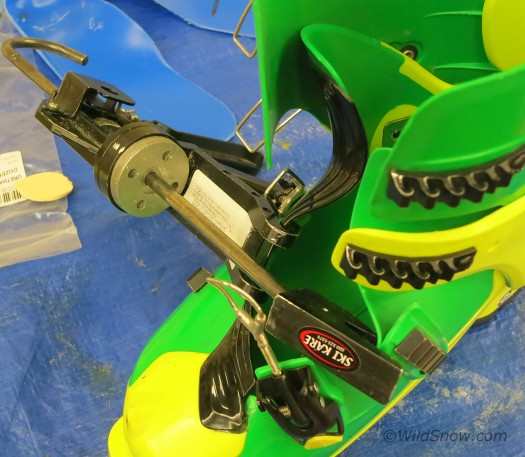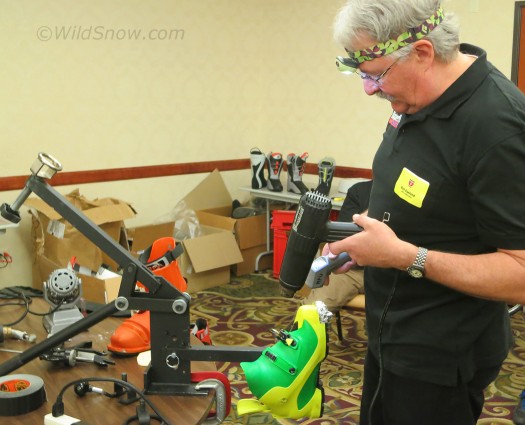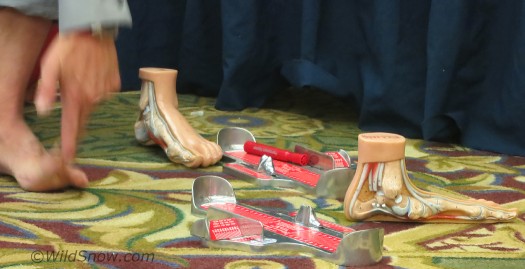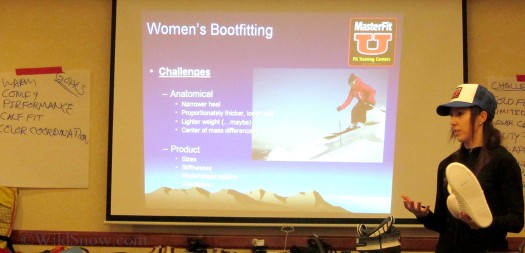
At MasterFit University, I noticed Lou salivating over a number of tools of the boot fitting trade. This one, he said, was 'what we've really been needing.' If he works on my boots, I'll buy him anything.
I’ve struggled with boot fit for years. Testing backcountry boots for WildSnow gives me wonderful opportunities to try different boots but getting the fit right is initially a slow and frustrating process for me. Part of my problem is not understanding the mechanics of boot fit. Therefore, when MasterFit University invited us to their two day boot fitting clinic, I was thrilled.
There’s quite a bit of analysis that goes into a good fit. The goal is to comfortably stabilize the foot in the ski boot. After that, you adjust all the boot’s biomechanical angles (cuff lean, side cant, ramp angle, etc.) to work with the skier’s body. With each training session delving deeper and deeper into the intricacies of the process, my respect grew for the master boot fitter.
I learned there are three core areas of focus:
1) the boot environment (size, angles, width)
2) the foot (flexibility, arch, issues such as bunions, narrow heel or hammer toes)
3) Ankle joint range of motion and toe dorsalflex
These three seemingly simple concepts got complicated real quickly with discussions of biomechanics, anatomy, alignment, assessment, footbed construction and shell and liner modifications. On top of that, most women face additional issues.
In Europe the percentage of male versus female skiers seems to be about 50/50. We observe a lower percentage of females in the US backcountry but a significant amount of women are enjoying the sport. Strangely, despite the 50/50 split in Europe, companies produce a much smaller percentage of truly women specific ski boot molds. Perhaps that’s because of the male dominated boot design and manufacturing culture? The majority of women’s ski boots are smaller sizes of men’s lasts. Given the differences in our anatomies, that gives us girls challenges and we have to go beyond just shopping for a boot that looks good with our cute ski suits.
Getting the right size boot shell is critical. For backcountry it’s measured by placing your bare foot in the boot shell without the liner, with the toe touching the front of the shell. A finger and half to two fingers space behind the heel is what you want. Your fingers or the boot fitters? The two can be quite different so beware of that gotcha that’s somewhat unique to lady’s boot fitting. Solution is to use a “fit stick” such as the one sold by Scarpa. Doing so keeps things standardized across the board.
Women typically have larger, lower calves, narrower heels, and a lower center of mass than men. Thicker calves can cause a high cuff to bite, and pitch you into excessive forward lean that hurts your knees and messes up your ski technique. Conversely, a lower center of mass can make it harder to get forward on skis — but excessive forward lean is not necessarily the best way to achieve that. Tendencies for knock knees require attention to side-to-side cuff angle that’s adjusted with cant rivets or custom padding on one side of the lower leg bone.

Bob Egeland, Board Certified Pedorthist, owner of Boulder Orthotics and master AT bootfitter, checking the heat of a boot for the punch.
Our snazzy dance shoes often cause bunions, higher insteps and tight tendons. During the seminar, like a crazed dentist, I ground a large divot in a shell to accommodate a bone spur. Shiny buckles are more than bling. The top buckles should be buckled securely for performance, but the bottom buckle can be closed with a lighter touch, easing numbness which can come from a high instep.
An interesting tidbit from the seminar: shops tend to stock only of few pairs of boots on either end of the sizing chart. Therefore, if you are a woman with small or big feet, availability can be another challenge if you don’t get your boots at the beginning of the season.
Women often have cold feet (my nickname, known only to a few, is Popsicle toes). A good fitting boot with the right sock will help. The boot, liner and footbed should provide the fit so rather than a thick comfy sock, a light sock is recommended. One fresh pair of socks for each day of touring is important since salt and minerals from sweating will inhibit the performance of a technical ski sock. And when driving to a trail head, you should only put on your socks right before you start to ski. Perspiration during the drive increases the chance of getting cold feet in the backcountry. Warmth can be enhanced by exterior neoprene boot covers, heavier liners, battery operated heaters embedded in insoles and heated boot bags. Unfortunately most of these come in boring black. Hopefully soon the top designers will focus their attention to ultra thin ski socks.
During one session, a MasterFit University instructor pulled out the stock foot bed of a new ski boot and it was flat as a pancake. Most design efforts focus on shell and liner construction. Most stock foot beds are generic and won’t give you the comfort or support you need. It’s a good idea to at lease replace it with an off the shelf insole, one that can be ground down to fit the liner. The goal is to stabilize the foot in the boot. A sloppy fit causes blisters and sluggish responsiveness. A good fit will have your foot encased in a warm handshake.
As you can surmise, there’s a lot involved with getting a boot to fit well. Attending MasterFit University helped me learn about my feet and their issues, and the knowledge will help me. But I’ll still work with a professional. Find one in your area. Luckily I have easy access to a number of good boot men, including Lou! A girl can never have enough shoes, but usually she’ll only have one pair of go-to backcountry boots. It pays to have them fit right.
Be ready for the first big storm and treat yourself to a few pairs of fresh, new socks. Buy ultralight wool ski socks.
WildSnow Girl, Lisa Dawson, is the luckiest girl in the world. Also known as Mrs. WildSnow.com, she tests whatever gear she wants. She gives the WildSnow family of websites the feminine voice.


